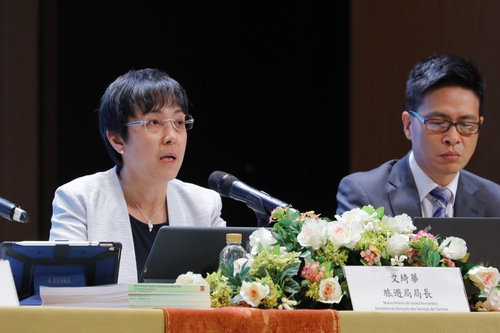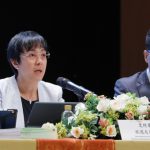 MGTO unveils the content of the final Master Plan
MGTO unveils the content of the final Master Plan
After two years of studies and formulation work of the Macao Tourism Industry Development Master Plan (referred to as the “Master Plan”), the Macao Government Tourism Office (MGTO) delivered the final version of the Master Plan today (28 September), bringing forth a blueprint for the development of Macao tourism industry in the next 15 years and a relevant guideline for future actions. The Master Plan aims to steer the progress of Macao tourism industry towards a parallel direction with the development policies of the Country and the Macao Special Administrative Region Government at all levels. Following the release of the Master Plan, a cross-departmental Master Plan Steering Group will be established and led by the Secretary for Social Affairs and Culture.
MGTO held a press conference today to unveil the content of the final Master Plan to the public. The press conference was attended by MGTO Director Maria Helena de Senna Fernandes and Deputy Directors Cecilia Tse and Cheng Wai Tong.
The Country’s Belt and Road Initiative and the Macao SAR Government’s vision to build Macao into a World Centre of Tourism and Leisure have opened up a new horizon of possibilities for Macao tourism industry on its road towards advancement. In 2015, MGTO began studying and formulating the Master Plan to devise systematic plans on building and managing the tourism economy. Guided by the goals in the Five-Year Development Plan (2016-2020) of the Macao Special Administrative Region, the Office has laid a blueprint to guide the future development of Macao tourism industry in the next 15 years in tandem with the city’s commitment to become a World Centre of Tourism and Leisure.
In the formulation process, MGTO has conducted a range of studies in different forms such as international forums, questionnaire surveys, site visits, interviews and benchmark analyses, to explore and analyze the current situation, strengths, challenges and potentials of Macao tourism industry in depth, whereby to develop a feasible proposal and plan with concrete details.
Furthermore, MGTO rolled out a two-month public consultation for the Master Plan from 23 May to 22 July 2016 to solicit a wide spectrum of opinions from the local community, the travel trade and nongovernmental organizations via different channels, with the aim to produce a Master Plan that would resonate profoundly with the demand of the local tourism industry along its development course. Following the consultation, MGTO announced and published a compilation report of public opinions on the "Macao Tourism Industry Development Master Plan” this January.
After two years of efforts, MGTO has completed the final Master Plan in 2017, distilling the collective wisdom of tourism experts, the governmental entities concerned, industry operators and professional organizations as well as different circles of the society. The Master Plan proposes 8 key objectives, 33 strategies and 91 action plans for short-, medium- and long-term implementation, encompassing an inclusive blueprint for tourism industry development at all levels and a relevant guide for future actions.
Following the release of the Master Plan, a cross-departmental Master Plan Steering Group will be established and led by the Secretary for Social Affairs and Culture, who will lead collaboration across departments and oversee the implementation progress of the action plans, such that various relevant departments of the Macao SAR Government can progressively forge ahead with related tasks and projects according to the goals and action plans set by the Master Plan, in strenuous pursuit of diversified and sustainable tourism development in Macao. In consideration of the ever-changing surroundings and the latest tourism prospect, MGTO will re-evaluate the Master Plan to keep pace with the progress of Macao’s transformation into a World Centre of Tourism and Leisure.
Starting from today, the “Macao Tourism Industry Development Master Plan – Comprehensive Report” (Chinese, English and Portuguese versions) and the “Macao Tourism Industry Development Master Plan – Summary Report” (Chinese, English and Portuguese versions) are available for download from the following link: http://masterplan.macaotourism.gov.mo/home-en/index.html.
For environmental concerns, MGTO has printed limited hard copies of the “Macao Tourism Industry Development Master Plan – Summary Report” for the public to obtain from MGTO’s reception counters at the 12th and 18th floor of the Hotline Building, as well as the Public Information Centre, the Service Centre of the Macao SAR and public libraries.
In early 2015, MGTO called for public tenders for the "Macao Tourism Industry Development Master Plan Service Provision” to propose an inclusive development plan for Macao tourism industry in the short, medium and long run, with the aim to devise a comprehensive Macao Tourism Industry Development Master Plan that would lay the foundation and direction for the future tourism development of Macao in the next 15 years.
The formulation work of the Master Plan proceeded in three phases. At the first phase, data were collected followed by an analysis of the current tourism situation. As a result, a preliminary draft of the Master Plan was prepared by the end of 2015. Second-phase tasks mainly involved launch of public consultation and preparation of an in-depth version of the Master Plan completed in 2016. At the third phase, the final version of the Master Plan was produced after a process of amendment and consolidation. Going through two years of formulation work, the final Master Plan is completed in 2017 for official release today (28 September).
View gallery


